Little Saigon
Guest Post: A “Living Museum” about
Little Saigon
April 30, 2015, marked the 40th anniversary of the fall of Saigon and the end of the Vietnam War. After the war, many Vietnamese refugees settled in Arlington, Virginia, and the Clarendon neighborhood briefly became known as “Little Saigon.” On Saturday, a cultural heritage event took place in Clarendon to recognize this important history.
The event featured a County Board proclamation, a temporary public art installation by Vietnamese-American artist Khánh H. Lê (now on view at the Center for Local History), and the unveiling of a smartphone audio tour of the historic buildings of Little Saigon. This audio tour is a “living museum” featuring the stories of Vietnamese immigrants, and Preservation Arlington welcomes this guest post by the tour’s producer and creative director, Judd Ullom. Learn more at www.littlesaigonclarendon.com.
I’m a master’s student in Urban Planning at Virginia Tech’s Northern Virginia campus. Last fall, I participated in a studio class that collected a number of recorded oral histories and artifacts from members of the Vietnamese community who immigrated to, resided or shopped in the Clarendon neighborhood of Arlington during the late 1970s and early 1980s following the fall of Saigon.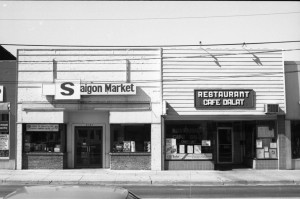
During this time, Arlington experienced an unprecedented level of immigration, which was concentrated primarily within the Clarendon neighborhood due to the cheap and flexible residential and commercial rents afforded by the construction of the Metro station; the fact that Clarendon had fallen out of favor as a retail destination made it all the more affordable. The neighborhood subsequently became known for a time as “Little Saigon” due to the many Vietnamese shops and restaurants that proliferated along Wilson Boulevard, primarily between N. Irving and N. Highland Streets.
Once the Metro was completed, rents quickly began to rise and forced many residents and business owners to relocate further west to Falls Church and the newly opened Eden Center.
By the time the Vietnamese began moving into the neighborhood during the 1970s, Clarendon had lost its status as the commercial ‘downtown’ of Arlington; retail had migrated to nearby auto-oriented shopping malls. Clarendon provided a home and opportunity to a people recently deprived of both by war, and the Vietnamese in turn helped revive and maintain Clarendon as a retail and restaurant destination during its most distressed years.
The Vietnamese community that remains in Arlington has long been interested in a historic marker commemorating their impact on Arlington, and the current oral history project has confirmed this. However, the demographics of Clarendon have changed radically in the last decade alone, and not many of its current residents know about its rich cultural history and significance.
As of 2013, more than half of Clarendon’s residents were between the ages of 20 and 34, many of whom moved here within the last ten years after Clarendon experienced an enormous amount of redevelopment. Many parts of Arlington are almost unrecognizable from how they looked just a decade ago.
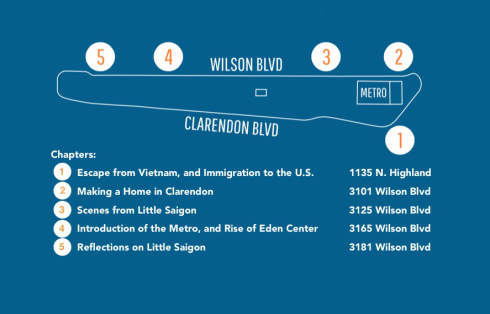
For my final project, I created a “living museum” self-guided walking tour commemorating the 40th anniversary of the Fall of Saigon, the subsequent refugee immigration to Arlington, and the Clarendon community once referred to as “Little Saigon” during the 1970s and 1980s. The walking tour is marked and narrated through the a series of unique storefront stickers reminiscent of museum placards that are placed on the exterior windows of businesses that were once part of the Little Saigon community (primarily along Wilson Boulevard and North Highland Street).
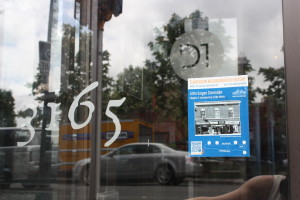
These stickers include Quick Response (QR) codes that link to a number of mini-documentaries on some element of the Little Saigon neighborhood, including the history of that particular building, and the individual businesses that occupied the space or spaces nearby. These documentaries contain excerpts from oral histories recently recorded in relation to this project, as well as pictures and articles from the time period, sourced from institutions or former and current community members. They explore themes of immigration, cultural preservation, and urban renewal and economic development.
Click on the storefront stickers or the chapter links below to view the videos. Download the accompanying audio-only walking tour here narrated by Kim O’Connell, playable on any digital audio device.
Chapter 1: Escape from Vietnam, and Immigration to the U.S. — Delhi Club; 1135 N. Highland Street
Chapter 2: Making a Home in Clarendon — The Hartford Building; 3101 Wilson Boulevard
Chapter 3: Scenes from Little Saigon — Goody’s; 3125 Wilson Boulevard
Chapter 4: Introduction of the Metro, and Rise of Eden Center — Don Tito’s; 3165 Wilson Boulevard
Chapter 5: Reflections on Little Saigon — Spider Kelly’s; 3181 Wilson Boulevard
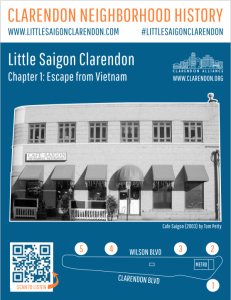
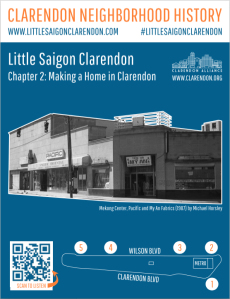

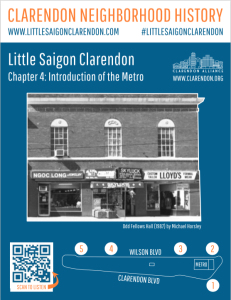

One thought on “Guest Post: A “Living Museum” about
Little Saigon”